Every successful venture in space is a hard won highly impressive technical achievement, but the James Webb Space Telescope and its successful observation of the deep universe is an accomplishment unlike any other.
The telescope is the largest ever sent into space. Its giant primary mirror is 21.7 feet in diameter, with an area of 270 square feet. The mirror is made of 18 hexagonal segments made of beryllium covered in a thin layer of gold, and polished to achieve maximum precision and reflectivity. It operates at -390ºF and is protected by a sunshield the size of a tennis court.
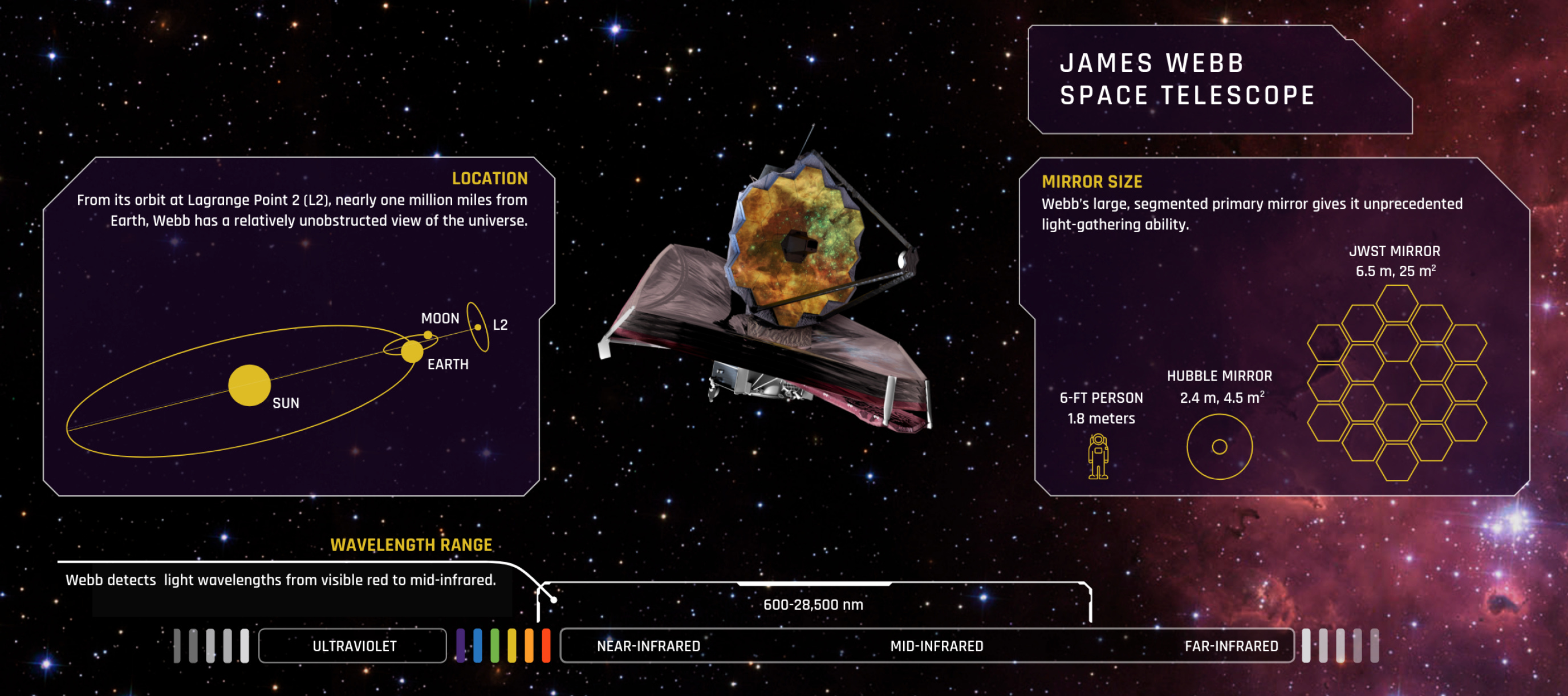
The precision design and fine-tuning of the 18 hexagonal segments, the apparatus, the secondary mirror, and the four observational instruments, add up to an incredible technical achievement. What makes the Webb Telescope a frontrunner for the most daunting technical challenge ever undertaken is that all of that had to blast off, power through Earth’s atmosphere, then delicately—and perfectly—unfold in space, while traveling out to Lagrange Point 2 (L2), 1 million miles from home.
A team of 20,000 people around the world worked for 20 years to make this device, and its transformational mission, possible. What they have built now opens a new age of scientific exploration and will likely produce an unprecedented wave of discoveries about the early and ongoing physics of everything.
During the lead-in to the release of the first science images, we heard from NASA astronomer Michelle Thaller:
“For everyone on Earth, this is your telescope.”
A new age of scientific exploration
Yesterday, with the release of the first science images from the James Webb Space Telescope (JWST), we were called to reimagine the Cosmos. The astonishing device has already revealed some of the earliest galaxies to have formed in the early evolution of the universe. The first full-color science image from the Webb Telescope is Webb’s First Deep Field, which imaged the deep and early universe far more quickly and in far greater detail than any Deep Field image taken with our previous best-ever astronomical science instrument.
Below, we share the full Webb images, in full-screen width, so you can dive in and explore them in detail.

The image was made by compiling infrared images, shot over a 12.5 hour period, into a mosaic. It shows the deepest view of our universe human beings have ever seen. It contains thousands of galaxies, and it covers just a tiny slice of the sky, equivalent to a grain of sand held at arm’s length by a person standing on the ground.
The gravity of a large galaxy cluster in the foreground creates a “lensing” effect, allowing us to see far more distant objects that would otherwise be too small and faint to be captured. The image is so detailed, it is possible to see distinct star clusters inside of some of the galaxies.
Webb’s distinctive “diffraction spikes” (two sets of overlapping 6-pointed star patterns) provide important information about the brightness of objects in the foreground. In the Deep Field view above, the far more distant galaxies are seen in stunning detail, while the bright stars in our own galaxy, in the foreground, trigger diffraction spikes that are created by the hard edges of the telescope itself.

The Webb Telescope also captured spectral information from these most distant galaxies ever observed, which now allows scientists to understand the chemistry of the early universe in ways never before possible. Key differences between stellar and galactic chemistry in the early universe and the more recent phenomena we have observed until now provide meaningful information about how the universe has evolved, how some of the early heavier elements (like carbon and oxygen) were created, and when.
Looking for signs of habitability around other stars
Webb also captured information about the composition of the atmopshere of a planet orbiting a star about 1,150 light years away—an “exoplanet” catalogued as ‘WASP-96b’. The data Webb captured revealed that this exoplanet has a significant amount of water vapor in its atmosphere.

This data not only reveals unprecedented detail about the atmospheric composition of a planet orbiting another star; it helps to illustrate the potential Webb holds for revolutioning our search for Earth-like planets beyond our Solar System, and for understanding the formation and evolution of planetary systems.
First ever glimpse of companion star at heart of Southern Ring Nebula
Webb’s near infrared (NIRCam) image of the Southern Ring Nebula is the most detailed ever captured. The image reveals areas on the boundary of the nebula where light bursts through, due to gaps in the dense gas cloud.
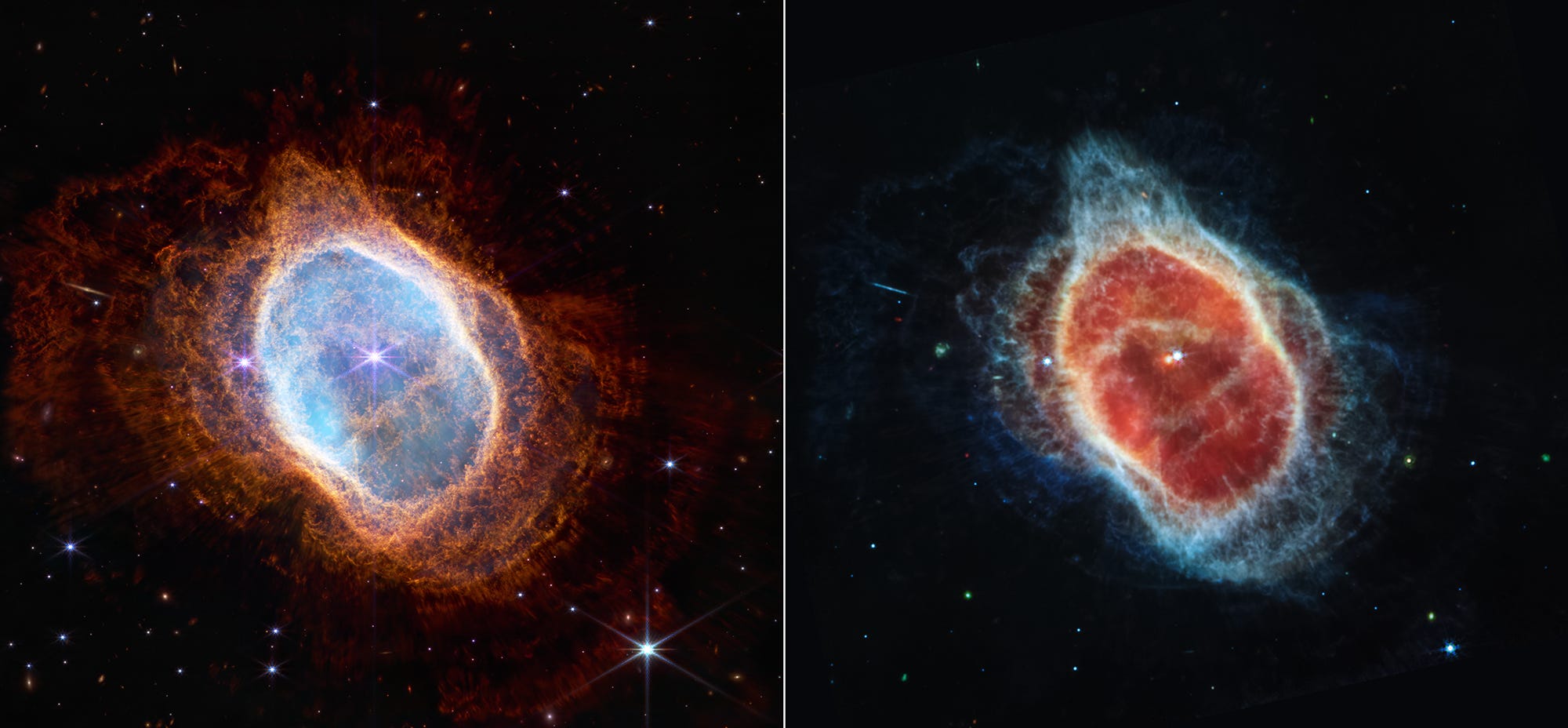
In a mid-infrared (MIRI) image, the outer edges of the nebula are blue-emitting hydrocarbon grains. The Webb also captured the first ever image of both of the stars at the center of the Southern Ring Nebula.
NASA’s news release notes the unique scientific value of this kind of close, detailed observation of a nebula surrounding a dying, but not yet extinct, star:
“Since planetary nebulae exist for tens of thousands of years, observing the nebula is like watching a movie in exceptionally slow motion. Each shell the star puffed off gives researchers the ability to precisely measure the gas and dust that are present within it.
… This dust will eventually enrich the areas around it, expanding into what’s known as the interstellar medium. And since it’s very long-lived, the dust may end up traveling through space for billions of years and become incorporated into a new star or planet.”
‘A ringside seat to galactic mergers and interactions’
The fourth image released was of Stephan’s Quintet—a cluster of five galaxies, closely locked together by gravity.
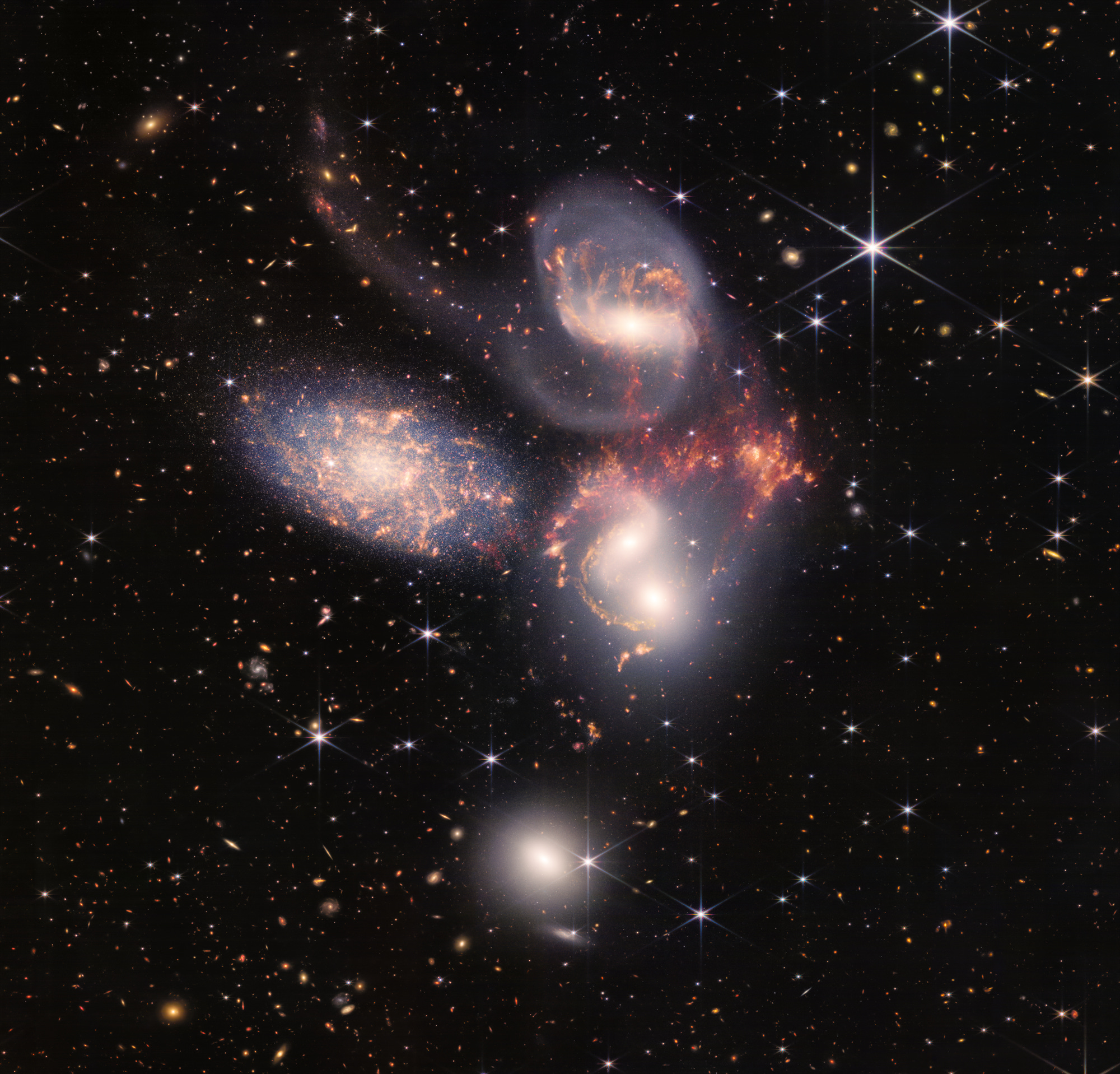
Two of the five galaxies are visibly in the process of merging. This is significant, because our Milky Way Galaxy is on course to merge with the Great Spiral in Andromeda, the other large galaxy in our Local Group, in about 4.5 billion years.
NASA noted the importance of the new detailed information about galactic interations, with lyrical description:
“Sparkling clusters of millions of young stars and starburst regions of fresh star birth grace the image. Sweeping tails of gas, dust and stars are being pulled from several of the galaxies due to gravitational interactions. Most dramatically, Webb captures huge shock waves as one of the galaxies, NGC 7318B, smashes through the cluster.”
The images of Stephan’s Quintet also reveal the activity of hydrogen gas and iron ions around an active black hole at the center of one of the five galaxies. This imaging provided the closest detail ever observed in matter and radiation spilling from an active black hole.
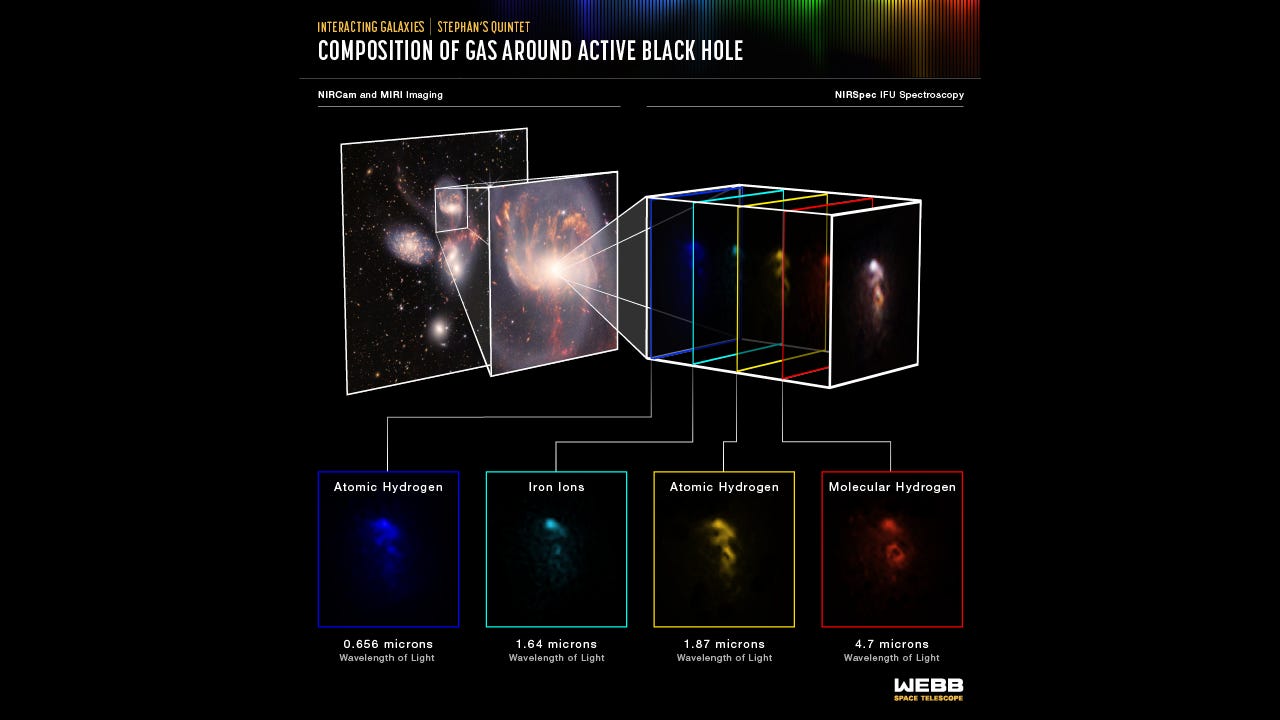
Unprecedented detailed view of a rapidly evolving star-forming region
The fifth image is the highest resolution image ever captured of the Carina Nebula, a dense cloud of gas and dust that acts as a major star-forming region. NASA’s press release describes the nebula as a “glittering landscape of star birth“.
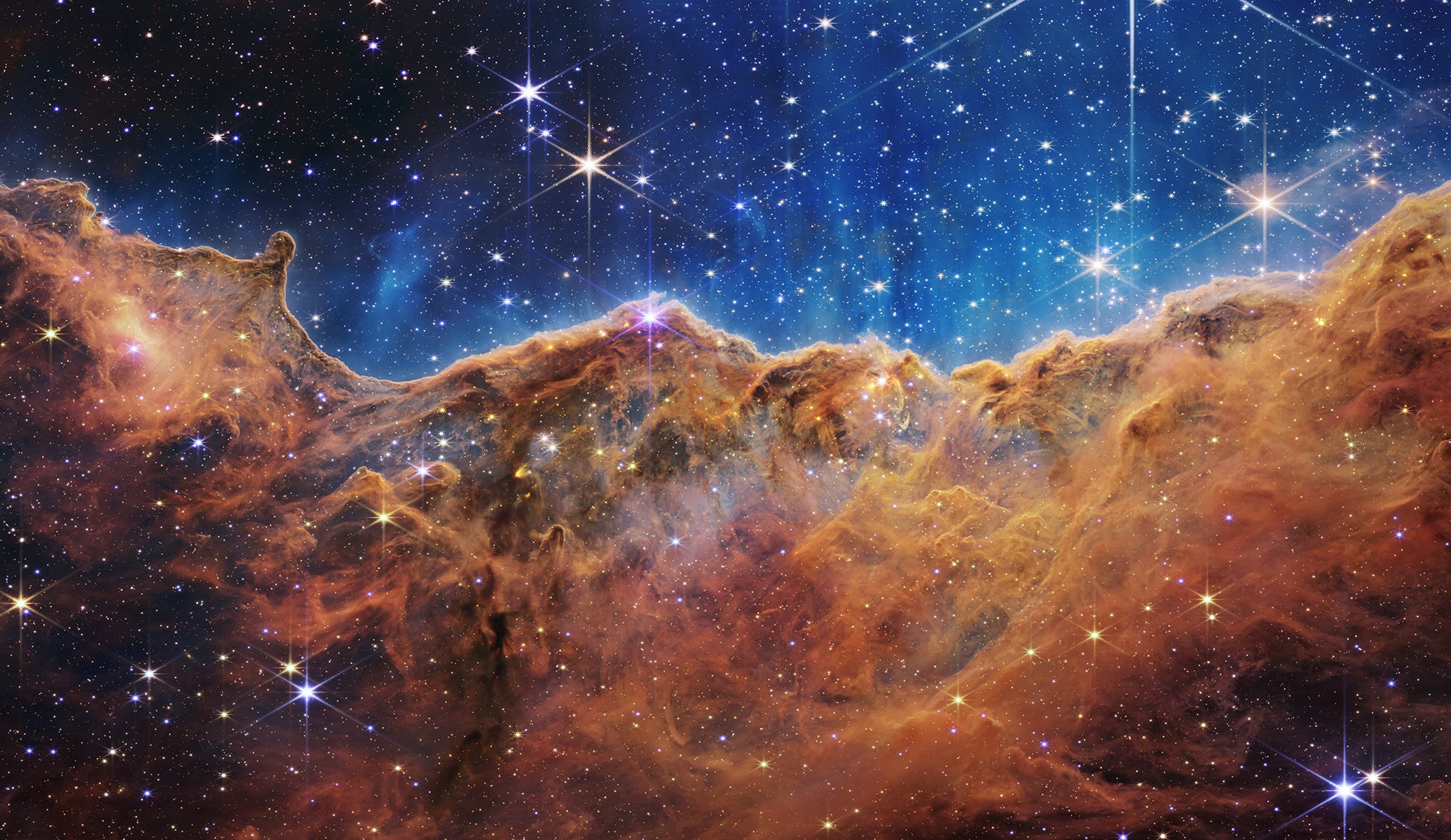
The Webb team explains:
“So-called mountains — some towering about 7 light-years high — are speckled with glittering, young stars imaged in infrared light. A cavernous area has been carved from the nebula by the intense ultraviolet radiation and stellar winds from extremely massive, hot, young stars located above the area shown in this image. The blistering, ultraviolet radiation from these stars is sculpting the nebula’s wall by slowly eroding it away. Dramatic pillars rise above the glowing wall of gas, resisting this radiation. The “steam” that appears to rise from the celestial “mountains” is actually hot, ionized gas and hot dust streaming away from the nebula due to the relentless radiation.”
This kind of intimate study of a hot, dense gas cloud where stars are born will help scientists understand better how our own Sun and Solar System came together, and how galaxies emerge and evolve.
Now, scientists will look to the beginning of time & survey our own Solar System
286 teams of scientists from around the world will now get to work through the Webb Telescope during its first year of operation. Science magazine reports:
“They will task the telescope with a range of inquiries: looking for ice-covered oceans on Uranus’s 27 moons, searching for elusive medium-size black holes, and resolving conflicting measurements of the expansion rate of the universe. But broadly speaking, they will use Webb to pursue two overriding themes, at opposite extremes of time and distance: the early universe and nearby planetary systems.”

It has also been reported that the Webb Telescope will be used to get a closer look at Earendel, a star in the Sunrise Arc Galaxy. It was discovered by the Hubble Space Telescope when its host galaxy was seen through the gravitational lensing effect. Earendel is the most distant star ever observed:
“The newly detected star is so far away that its light has taken 12.9 billion years to reach Earth, appearing to us as it did when the universe was only 7 percent of its current age, at redshift 6.2. The smallest objects previously seen at such a great distance are clusters of stars, embedded inside early galaxies.”
NASA Administrator Bill Nelson chose the words of Carl Sagan to highlight the significance of the images created by the Webb Space Telescope:
“Somewhere, something incredible is waiting to be known.”
This investment in science will result in new discoveries that not only tell us about the faraway or early universe, but add detail and precision to our understanding of basic physics, chemistry, and the conditions that are needed to sustain life. We need to remember that rigorous, cooperative science can solve big problems, and we need to make smarter decisions here on Earth, in line with that understanding.
Follow the James Webb Space Telescope and the science it generates, at WebbTelescope.org






